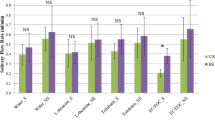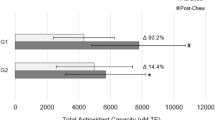Abstract
For decades, it is believed that astringency is due to the polyphenol-induced complexation of proline-rich salivary proteins in the oral cavity. In order to compare for the first time the human sensory threshold concentrations and the salivary protein binding activity of a series of astringent stimuli, human saliva protein was incubated for 5 min at 37 °C in the presence of astringent food-derived compounds and, after micro-centrifugation, the amount of the target molecules in the supernatant was quantitatively determined by HPLC-UV/Vis. Significant protein binding was observed for (−)-epigallocatechin-3-gallate, (−)-gallocatechin-3-gallate, (+)-gallocatechin, and (−)-catechin-3-gallate, all of which containing at least one galloyl moiety in the molecule and exhibiting rather high sensory thresholds of more than 200 μmol/L. In comparison, (+)-catechin and procyanidin B2, both lacking in any galloyl function, showed only comparatively low binding activity and, most interestingly, quercetin-3-O-α-l-rhamnopyranosyl-(1 → 6)-β-d-glucopyranoside and 3-carboxymethyl-indole-1-N-β-d-glucopyranoside did not show any protein binding at all, although the later N- and O-glycosides exhibited extraordinarily low sensory threshold concentrations of less than 0.001 and 0.0003 μmol/L, respectively. The data give some first evidence that the quantity of the non-bound, “free” astringent stimulus in the saliva liquid might be more closely related to the sensory perception of astringency than the amount complexed or precipitated by proteins. It is therefore questionable as to whether oral perception of astringency is related to the complexation and/or precipitation of salivary proteins.



Similar content being viewed by others
References
Haslam E, Lilley TH (1988) Crit Rev Food Sci Nutr 27:1–41
Luck G, Liao H, Murray NJ, Grimmer HR, Warminski EE, Willianson MP, Lilley TH, Haslam E (1994) Phytochem 37:357–371
De Freitas V, Mateus N (2001) J Agric Food Chem 49:940–945
Baxter NJ, Lilley TH, Haslam E, Williamson MP (1997) Biochem. 36:5566–5577
Charlton AJ, Baxter NJ, Khan ML, Moir AJG, Haslam E, Davies AP, Williamson MP (2002) J Agric Food Chem 50:1593–1601
Murray NJ, Williamson MP, Lilley TH, Haslam E (1994) Eur J Biochem 219:923–935
Breslin PAS, Gilmore MM, Beachamp GK, Green BG (1993) Chem Senses 18:405–417
Prinz JF, Lucas PW (2000) J Oral Rehabil 27:991–994
Bathe-Smith EC, Swain T (1962) In: Mason HS, Florkin AM (eds) Comparative biochemistry, Academic Press, New York, pp 755–809
Adams DO, Habertson J (1990) Am J Enol Vitic 50:247–252
Monteleone E, Condelli N, Dinnella C, Bertuccioli M (2004) Food Qual Pref 15:761–769
McManus J, Lilley TM, Haslam E (1983) In: Hedin PA (ed) Plant resistance to insects. ACS symposium series 208, American Chemical Society, Washington DC, pp 123–137
Yokotsuka K, Singleton VL (1987) Am J Enol Vitic 38:199–206
Green BG (1993) Acta Psychol 84:119–125
Haslam E (1996) J Nat Prod 5:205–215
Scharbert S, Holzmann N, Hofmann T (2004) J Agric Food Chem 52:3498–3508
Schwarz B, Hofmann T (2007) J Agric Food Chem 55:1394–1404
Schwarz B, Hofmann T (2007) J Agric Food Chem 55:1405–1410
Stark T, Bareuther S, Hofmann T (2005) J Agric Food Chem 53:5407–5418
Glabasnia A, Hofmann T (2006) J Agric Food Chem 54:3380–3390
Noble AC (2002) In: Given P, Paredes D (eds) Chemistry of taste—mechanism, behaviours, and mimics. ACS symposium series 825, American Chemical Society, Washington DC, pp 192–201
Wilson MF (2005) J Chem Ecol 10:493–498
Kallithraka S, Bakker J, Clifford MN (2000) J Sci Food Agric 81:261–268
Tachibana H, Koga K, Fujimura Y, Yamada K (2004) Nat Struct Mol Biol 11:380–381
Hakkinen L, Uitto VJ, Larjava H (2000) Periodontol 24:127–152
Author information
Authors and Affiliations
Corresponding author
Rights and permissions
About this article
Cite this article
Schwarz, B., Hofmann, T. Is there a direct relationship between oral astringency and human salivary protein binding?. Eur Food Res Technol 227, 1693–1698 (2008). https://doi.org/10.1007/s00217-008-0895-x
Received:
Revised:
Accepted:
Published:
Issue Date:
DOI: https://doi.org/10.1007/s00217-008-0895-x




